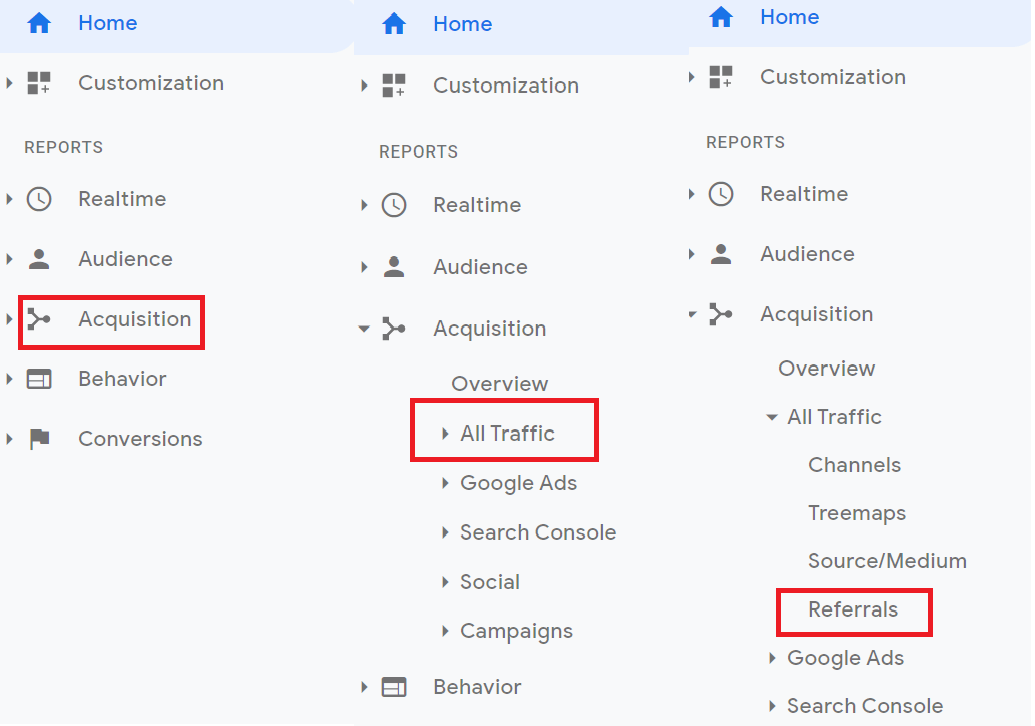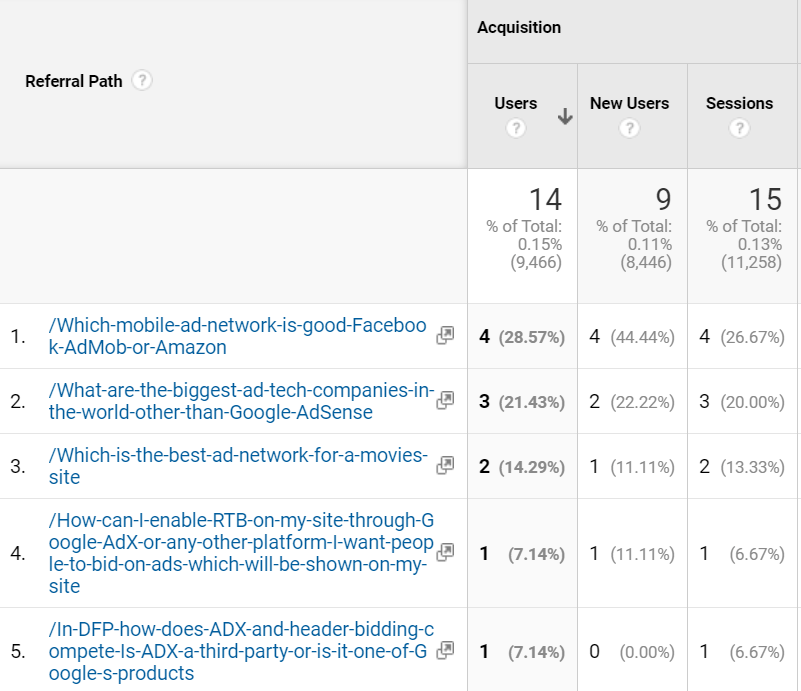Ad monetization is virtually redundant without receiving adequate traffic on your website. This is where building strategies for referral traffic can prove pivotal in earning revenue.
Referral traffic opens up many channels to divert traffic from other domains to your website. If done right, there are practically no restrictions on the amount of referrals you can possibly get.
In this post, we cover the definition, benefits, and strategies of referral traffic and how it can help you strengthen your brand.
What is Referral Traffic?
It is easy to assume that a website’s popularity is directly proportional to the traffic it is getting. In reality, increasing organic traffic is a well-crafted strategy relying on many different sources and methods.
Before we understand what referral traffic is exactly, we must acquaint ourselves with the main kinds of traffic.
| Type of Traffic | Method of Reception |
| Direct | When users type the exact URL of your website in the address bar |
| Organic/Search | This is search-based traffic received through a well-built SEO strategy. This includes keyword research, writing unique content, etc. |
| Referral | When a user visits your website through a link placed on an external web page. |
| Social | This traffic is generated from organic promotion on social media websites. It’s not the same as paid traffic because there is no financial investment involved. |
| Paid | This is the direct opposite of organic/search traffic. You need to pay for your website’s ads and can have complete control over the kind of audience you wish to target. |
* Up until 2013, Google Analytics included social media traffic under referral. Now with the upsurge of social media websites including Facebook, Instagram, Pinterest, and others., social media traffic is considered as an exclusive traffic type. Though both may now seem different, they are the same in terms of technicality.
As is evident, referral and social traffic are quite different from the other kinds. Unlike paid ads, in most cases, referral traffic strategy does not involve spending additional money. Nor can publishers use tools for active keyword researching resulting in search-based traffic. Referral traffic is built on building relationships and improving your website’s popularity in your industry. Therefore, referral traffic requires an independent strategy.
Referral traffic can be majorly achieved through a combination of link building, and persistent social media sharing. (We’ll get to this in a while).
How to Track Referral Traffic Sources
Most publishers use a web analytics service for tracking traffic and user engagement on their websites. Analyzing metrics such as bounce rate, number of users, etc. provide actionable insights into our SEO and traffic strategies. This is important because a higher user retention rate means users scroll down to the bottom of the page, delivering more opportunities for ad serving and viewability.
Since Google Analytics is the most popular and free web analytics service, let’s focus on that. Here’s how you can track referral traffic in GA:
- Log in to your Google Analytics account
- In the navigation menu, click on the Acquisition tab
- Under Acquisition, click on All Traffic >> Referrals

Some of the information that the referral traffic report provides include:
- Different domains and number of backlinks provided by them
- Performance (number of users, session, bounce rate, etc.) of each backlink
- Average time per session through a particular backlink
How to check the referral path
Referral path is tracking the exact page or the link that made a user visit your website. In the referral report offered by Google Analytics, source domains from which you are receiving traffic are listed as the primary information. You can check the referral path by clicking on any of the source domains.

Tips for Increasing Referral Traffic
Web publishers can do a variety of things for growing referral traffic.
Publish Guest Posts
Guest blog posts can get easy access to a lot of referral traffic on your website. You can do this by backlinking between the content, mentioning your website in the author bio or a call-to-action at the end of the post. Make sure that the website you choose for guest blogging is related to your industry and receives high traffic on most days. You can also tag influencers in your guest blogs which in turn, may catch their attention and get more referral traffic to your website.
Appear as a Guest in Podcasts
One of the relatively newer content formats to have experience spectacular growth is podcasts. According to PodCast Insights, there are approximately 30 million podcasts available as of now. Podcasts online are available for almost every topic and publishers can leverage that by contacting hosts for getting included as a guest. Podcast descriptions generally include backlinks to the guests’ websites, which in turn fetches referral traffic. Publishers should look for podcasts falling in their niche and contact the hosts for either including a backlink or getting invited as a guest.
Create More Effective Content Formats
For some topics, instead of writing a lengthy blog post, consider creating a video or an infographic. If done right, these are timeless resources and publishers may massively share your content resource on relevant topics. You can include a link to your website at the end of the infographic which will fetch you considerable traffic. Additionally, you can also create listicles or quizzes on your website. People generally want to include a link in these kinds of posts and there is a good chance of organic social media promotion.
Promote on Social Media
For an average internet user, social media websites are often the sites where they spent most of their online time. This is a great opportunity for nearly all publishers to leverage this opportunity and create noticeable social media presence.
Take NowThisNews for example, which received approximately 750k users on their website in April 2020, according to SimilarWeb. Below is a breakdown of their traffic sources. As it’s clear, the website majorly relies on referral traffic which makes up for 53.16% of their total traffic.

Leverage social bookmarking websites
Although social bookmarking websites may have gone slightly down in terms of popularity, they still remain highly relevant for referral traffic. Social bookmarking websites allow users to save a post for future reference. The advantage with them is that they allow you to pin different websites, which can fetch consistent referral traffic. Here are some popular social bookmarking websites that all publishers can use for generating referrals:
Reddit.com received a whopping 1.54 billion users in April, 2020. Reddit has subreddits related nearly to every possible topic and a simple Google search can fetch you desired communities for interaction. If your posts make it to the front page, there is a good chance that your website will receive a huge amount of referral traffic.
Quora
The advantage with Quora is that it performs extremely well in Google search result pages. If your answer (with an included link) to a particular question makes it to the top of a page getting consistent traffic, the referral traffic you will receive will be pretty consistent.
Flipboard is a news aggregator website and has been popular since its inception. As of August 2018, the company had approximately 11,000 publishers applying for their webpages to get featured on Flipboard. News publishers can get massive referral traffic if they build a strategy to get featured on Flipboard.
GoogleNews
When it comes to news publishers, how can anyone refrain from mentioning Google. Probably the most popular news aggregator, Google News Initiative provides a platform for publishers to get recurring traffic on their websites. Google has a Publisher Center for its News Initiative that helps publishers not only appear on the website but also gain considerable ranking.
Benefits of Referral Traffic
More Valuable Visitors
As we have already mentioned, one of the key methods of getting more referral traffic is through effective link building. If done right, authentic visitors from trusted websites visit your website, thus increasing the positive score of your website.
Positive Ranking
According to a report on ranking factors conducted by SEMRush, the number of backlinks in a domain is directly proportional to its ranking in SERP. This also proves beneficial whenever a broad core algorithm update is rolled out by Google.
More Networking Opportunities
Backlinks are mostly built by interacting and initiating conversations with publishers of your industry. This provides a chance to build a better network, eventually resulting in more meaningful collaborations. The higher the authentic mentions your website has in an external website, the better your domain authority will be.
The Way Forward
It is often said that organic traffic is the best way to make your website popular and rank higher on Google SERP. But this cannot be true for all publishers. Some publishers can also improve their website ranking and traffic by devising a strategy for backlinking. If done right, referral traffic can prove beneficial for all publishers, irrespective of the target audience.

Shubham is a digital marketer with rich experience working in the advertisement technology industry. He has vast experience in the programmatic industry, driving business strategy and scaling functions including but not limited to growth and marketing, Operations, process optimization, and Sales.







